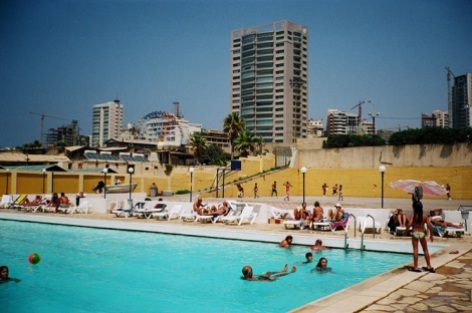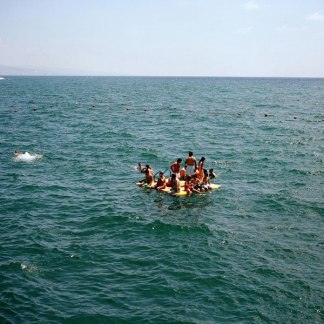post 188/365

Change occurs very rapidly in the city of Beirut. It has changed often and quickly and is still changing now. The Sporting Club, located in Al-Manara, lies there guarding the sea, in the shadows of the ferris wheel or the Luna park and facing the sakhret el Rawche (the pigeon’s rock). It stands there in stark contrast to the anarchic growth of high-rise buildings surrounding it. Untouched by modern esthetics, it remains one of those great city institutions. This beloved venue that evokes strong feelings of nostalgia among the city’s residents is the last man standing in terms of guarding Beirut’s old glamour days, maintaining its sense of identity.
Beirut is a city of sun-worshippers. Lebanon’s golden era in the 1960s revolved around its vibrant coastal restaurants and clubs, and during the civil war from 1975 to 1990, residents would take advantage of lulls in the fighting to swim in the sea and sunbathe for a few hours. With the same look and feel since its opening in the 60s, Beirut’s Sporting Club is beloved by sun worshippers across the city: from young girls posing for their instagram uploads, older men fishing under colorful umbrellas, book worms blocking the world out with their books and magazines, boys and men getting sweaty on the basketball court, oiled-up portly men playing backgammon under straw hats, and the regular customers whose attendance doesn’t stop even in winter enjoying their Almazas in between swimming sessions.
Named after The Sporting Club in Monte Carlo, Beirut’s version of the beach club was founded in 1953 by George Abu-Nassar who had just graduated from university and was looking for a venture to have a good time with. Back then, the plot of land had only a small cafe and a small pool used by the cafe’s clients, what is today the children’s pool. When Abu-Nassar found this land, he was inspired to develop a private beach club on it and convinced a partner to invest with him. The idea of a beach club was avant-garde back then as Beirut was still somehow a conservative city.
When water sports and the tanned aesthetic took Beirut by storm in the mid-1950s, businessmen would stop by “Sporting” during the day to have lunch and a swim before going back to work; the club is still no more than 10 minutes from the major business districts. The club was also host to film crews, as well as airline pilots and flight attendants serving the huge international hub that Beirut’s airport were at the time. Due to the large number of Nordic hostesses, more people were interested in joining the club.
What truly made Sporting Club take off, however, was the image of exclusivity that George Abu-Nassar created around it, making membership extremely sought after. The only way one could become a member in Sporting was to be recommended by a member, and, as the members’ list was not shared with the general public, identifying who to recommend became a challenging experience. People took to the idea seriously and the Sporting Beach Club grew from one generation to the next with members who were the partners’ friends and friends of friends, creating a niche of a faithful clientele base, which ensured continuity over the years and created a familial home-like atmosphere at the club. The club grew in dimension as George Abu-Nassar gradually added land to it until it reached its current area of 10,000 square meters.
The club comprises of multiple restaurants, swimming pools, terraces dotted with yellow canopies and white sun loungers, and a small rock jetty that leads out to the sea with a killer view. It is the westernmost point in Lebanon where the austere concrete slabs end and the porous rock begins, over looking the waves that crash on the Pigeon Rocks. At sporting, overworked waiters, bringing beer and food add to its décor, as well as the lifeguard sitting on the children’s pool who has been working there since its hay days. It reflects a glimpse of the family ties, religious sensitivities, and shared pleasures that bind Beirut together, that have always bound this place together and occasionally driven it apart.
There is something quiet poetic about it. The way it’s dilapidated yet denotes old luxury, reflecting images of old Beirut. “This understated sanctuary drips with nostalgia for an authentic Beirut culture. It wears its unassuming status with pride, denoted by worn-off wall paint, concrete platforms and rusty umbrellas emblazoned with advertisements for the much-loved local beer, Almaza. The club is an emblem of the country itself: a place where people of all ages, sect and social standing mix, lured by the sun, and freshly caught fish snacks”.
This seaside getaway to Lebanon’s beacon of faded glamour is at its best when the sunsets and the sky explodes into fiery colors echoed on the Mediterranean Sea. When the sun goes down unassumingly embracing Beirut with its last strings of light.
To my Sporting, thank you for all the memories, thank you for the bruises slipping while I ran to my mother to show her my new drawings, thank you for allowing me to share my experience as a young child with my sons, and mostly thank you for keeping my memory alive.
Beautiful photos taken by the artist Rasha Kahil that are included in this post: http://rashakahil.com/The-Sporting-Club























